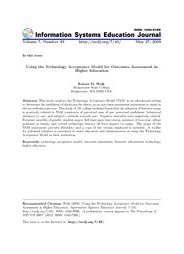Volume 7
Volume 7, Number 43 |
May 27, 2009 |

|
Robert M. Wolk
|
Abstract: This study employs the Technology Acceptance Model (TAM) in an educational setting to determine the usefulness of deploying the theory as an outcomes assessment instrument to assist in the accreditation process. The study of 131 college students found that the adoption of Internet usage is positively related to TAM constructs of perceived ease of use, perceived usefulness, behavioral intention to use, and subject’s attitude towards use. Negative attitudes were negatively related. External variables of gender, student major, full-time/part-time status, presence of four-year college graduate in family, and overall technology literacy all have impact on usage. The usage of the TAM instrument provides flexibility and a copy of the version employed is included. A toolkit for potential adopters is presented to assist educators and administrators in using the Technology Acceptance Model in their institution.
Keywords: technology acceptance model, outcomes assessment, Internet, information technology, higher education
Download this issue: ISEDJ.7(43).Wolk.pdf (Adobe PDF, 18 pages, 800 K bytes)
Preview the contents: Wolk.j.txt (ASCII txt, 43 K bytes)
Recommended Citation: Wolk (2009). Using the Technology Acceptance Model for Outcomes Assessment in Higher Education. Information Systems Education Journal, 7 (43). http://isedj.org/7/43/. ISSN: 1545-679X. (A preliminary version appears in The Proceedings of ISECON 2007: §3512. ISSN: 1542-7382.)